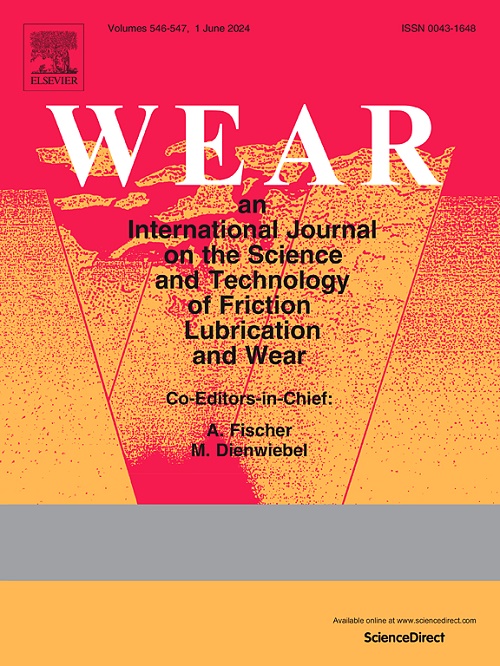Study of tribological behavior of atmospheric plasma sprayed (Ni-5wt% Al)-Bi coating at room temperature to 800 °C
IF 5.3
1区 工程技术
Q1 ENGINEERING, MECHANICAL
引用次数: 0
Abstract
In this study, bismuth (Bi) was incorporated in a plasma sprayed Ni-5wt% Al coating. The results demonstrate that Bi reacts with ambient oxygen and the Ni matrix during spraying to produce δ-Bi2O3 and NiBi3. The lubricity of Bi and δ-Bi2O3 enables the coating to exhibit low friction at 25 °C. However, the soft properties of Bi, δ-Bi2O3, and NiBi3 reduce the hardness and low-temperature wear resistance of the coating. In particular, at 200 °C, the soft and brittle NiBi3 increases the wear rate of the coating. Above 400 °C, with the phase transition from NiBi3 to NiBi and intense tribo-oxidation reaction, the worn surface gradually forms a highly strong and tough tribo-layer, comprising NiBi, α-Bi2O3, δ-Bi2O3, NiO, Al2O3, and Bi24Al2O39. Consequently, friction and wear decrease as the temperature increases. By 800 °C, the coating achieves optimal friction reduction and exhibits an antiwear behavior. Moreover, the tribo-layer formed at 800 °C provides a continuous antiwear effect even when the temperature drops below 400 °C.
室温~ 800℃大气等离子喷涂(Ni-5wt% Al)-Bi涂层摩擦学行为研究
在这项研究中,将铋(Bi)加入到等离子喷涂的Ni-5wt% Al涂层中。结果表明:喷淋过程中,Bi与环境氧和Ni基体反应生成δ-Bi2O3和NiBi3;Bi和δ-Bi2O3的润滑性使涂层在25℃时表现出低摩擦。然而,Bi、δ-Bi2O3和NiBi3的软性质降低了涂层的硬度和低温耐磨性。特别是在200℃时,软脆的NiBi3增加了涂层的磨损率。在400℃以上,随着NiBi3到NiBi的相变和强烈的摩擦氧化反应,磨损表面逐渐形成由NiBi、α-Bi2O3、δ-Bi2O3、NiO、Al2O3和Bi24Al2O39组成的高强度、高韧性的摩擦层。因此,摩擦和磨损随着温度的升高而减小。在800°C时,涂层达到最佳的摩擦减量,并表现出抗磨性能。此外,在800°C时形成的摩擦层即使在温度降至400°C以下时也能提供持续的抗磨效果。
本文章由计算机程序翻译,如有差异,请以英文原文为准。
求助全文
约1分钟内获得全文
求助全文
来源期刊

Wear
工程技术-材料科学:综合
CiteScore
8.80
自引率
8.00%
发文量
280
审稿时长
47 days
期刊介绍:
Wear journal is dedicated to the advancement of basic and applied knowledge concerning the nature of wear of materials. Broadly, topics of interest range from development of fundamental understanding of the mechanisms of wear to innovative solutions to practical engineering problems. Authors of experimental studies are expected to comment on the repeatability of the data, and whenever possible, conduct multiple measurements under similar testing conditions. Further, Wear embraces the highest standards of professional ethics, and the detection of matching content, either in written or graphical form, from other publications by the current authors or by others, may result in rejection.
 求助内容:
求助内容: 应助结果提醒方式:
应助结果提醒方式:


